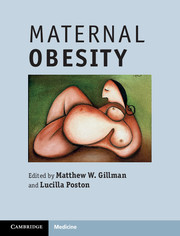Book contents
- Frontmatter
- Contents
- Contributors
- Preface
- Section 1 Trends and determinants of obesity in women of reproductive age
- Section 2 Pregnancy outcome
- Section 3 Long-term consequences
- Section 4 Interventions
- 14 Intervention strategies to improve outcome in obese pregnancies: focus on gestational weight gain
- 15 Interventional strategies to improve outcome in obese pregnancies: insulin resistance and gestational diabetes
- 16 Intervention strategies to improve outcome in obese pregnancies: micronutrients and dietary supplements
- 17 Pre-pregnancy bariatric surgery: improved fertility and pregnancy outcome?
- Section 5 Management and policy
- Index
- Plate Section
- References
14 - Intervention strategies to improve outcome in obese pregnancies: focus on gestational weight gain
from Section 4 - Interventions
Published online by Cambridge University Press: 05 August 2012
- Frontmatter
- Contents
- Contributors
- Preface
- Section 1 Trends and determinants of obesity in women of reproductive age
- Section 2 Pregnancy outcome
- Section 3 Long-term consequences
- Section 4 Interventions
- 14 Intervention strategies to improve outcome in obese pregnancies: focus on gestational weight gain
- 15 Interventional strategies to improve outcome in obese pregnancies: insulin resistance and gestational diabetes
- 16 Intervention strategies to improve outcome in obese pregnancies: micronutrients and dietary supplements
- 17 Pre-pregnancy bariatric surgery: improved fertility and pregnancy outcome?
- Section 5 Management and policy
- Index
- Plate Section
- References
Summary
Introduction
Excessive gestational weight gain (GWG) is common and on the rise. While mean weight gains tend to be lower among women entering pregnancy at higher pre-pregnancy weights, weight gain ranges associated with optimal outcomes are also lower for heavier women [1,2]. Thus overweight and obese women are substantially more likely to gain more weight than recommended (“excessive weight gain”), compared with women who were normal weight or underweight entering pregnancy [1].
As summarized in Chapter 4, a large number of observational studies have demonstrated increased risks for adverse short- and long-term pregnancy outcomes associated with excessive GWG [1,3]. For the mother, these adverse outcomes include gestational glucose intolerance, cesarean or complicated vaginal delivery, failure to initiate or maintain breastfeeding, and postpartum weight retention [3,4]. For the child, they include large for gestational age, birth trauma, and infant mortality, as well as increased risk for later obesity [2,3,5–7]. Observational data further suggest that risks for many adverse outcomes associated with greater GWG are similar or greater among obese women than among women of normal pre-pregnancy weight. In studies of birth outcomes among obese women, higher gains appear to raise the risk of large for gestational age more strongly than they reduce the risk of small for gestational age birth [5,8–13]. These findings suggest that reducing GWG among obese women may have beneficial effects without causing undue risk.
- Type
- Chapter
- Information
- Maternal Obesity , pp. 151 - 178Publisher: Cambridge University PressPrint publication year: 2012
References
- 2
- Cited by

